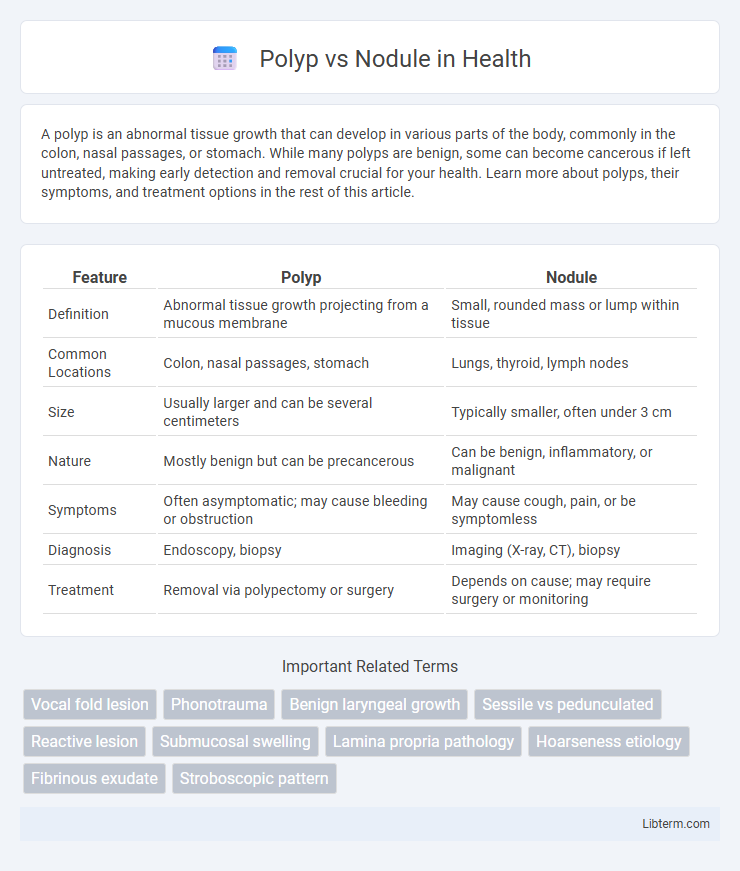A polyp is an abnormal tissue growth that can develop in various parts of the body, commonly in the colon, nasal passages, or stomach. While many polyps are benign, some can become cancerous if left untreated, making early detection and removal crucial for your health. Learn more about polyps, their symptoms, and treatment options in the rest of this article.
Table of Comparison
| Feature | Polyp | Nodule |
|---|---|---|
| Definition | Abnormal tissue growth projecting from a mucous membrane | Small, rounded mass or lump within tissue |
| Common Locations | Colon, nasal passages, stomach | Lungs, thyroid, lymph nodes |
| Size | Usually larger and can be several centimeters | Typically smaller, often under 3 cm |
| Nature | Mostly benign but can be precancerous | Can be benign, inflammatory, or malignant |
| Symptoms | Often asymptomatic; may cause bleeding or obstruction | May cause cough, pain, or be symptomless |
| Diagnosis | Endoscopy, biopsy | Imaging (X-ray, CT), biopsy |
| Treatment | Removal via polypectomy or surgery | Depends on cause; may require surgery or monitoring |
Introduction to Polyps and Nodules
Polyps are abnormal tissue growths protruding from mucous membranes, commonly found in organs such as the colon, stomach, and nasal passages. Nodules are small, firm lumps that can develop in various tissues including the thyroid, lungs, and vocal cords, often indicating inflammation or benign tumors. Differentiating between polyps and nodules is crucial for accurate diagnosis and treatment planning based on their distinct morphological and clinical characteristics.
Defining Polyps: Characteristics and Types
Polyps are abnormal tissue growths that protrude from mucous membranes, commonly found in areas such as the colon, nasal cavity, or vocal cords. These growths vary in size, shape, and histological type, including adenomatous, hyperplastic, and inflammatory polyps, each with distinct potential for malignancy. Understanding the cellular makeup and morphological characteristics of polyps is essential for diagnosis, prognosis, and treatment planning in clinical practice.
Understanding Nodules: Key Features and Varieties
Nodules are small, solid masses commonly found in organs such as the thyroid, lungs, or vocal cords, characterized by their firmness and deeper tissue infiltration compared to polyps. Key features include their size, usually under 3 centimeters, and their potential to indicate benign or malignant conditions depending on their shape, margin, and ultrasound characteristics. Varieties of nodules include colloid, cystic, and solid types, each requiring specific diagnostic evaluation to determine appropriate treatment and prognosis.
Causes of Polyps and Nodules
Polyps in the respiratory tract primarily develop due to chronic inflammation, irritation from infections, allergies, or exposure to environmental pollutants, leading to abnormal tissue growth. Vocal fold nodules typically result from vocal strain or misuse, causing localized swelling from repetitive trauma to the vocal cords, commonly seen in professional voice users. Understanding these distinct etiologies aids in accurate diagnosis and targeted treatment strategies for effective symptom management.
Common Symptoms and Warning Signs
Polyps and nodules commonly present with persistent hoarseness, throat discomfort, and vocal fatigue due to irritation or inflammation of the vocal folds. Warning signs include a persistent voice change lasting more than two weeks, difficulty swallowing, and the sensation of a lump in the throat. Early diagnosis through laryngoscopy is crucial to differentiate polyps, which are typically softer and fluid-filled, from nodules, which are harder and fibrous, preventing progression to chronic voice disorders.
Diagnostic Methods: Polyps vs Nodules
Diagnostic methods for distinguishing polyps from nodules primarily involve laryngoscopic examination, with video stroboscopy offering detailed visualization of vocal fold vibration and lesion characteristics. High-resolution imaging techniques, such as ultrasound and MRI, assist in assessing the size, depth, and tissue composition, providing critical differentiation between benign polyps and fibrous nodules. Biopsy remains the definitive diagnostic tool, enabling histopathological analysis to confirm the lesion type and guide appropriate treatment.
Risk Factors and Associated Conditions
Polyps are often linked to chronic inflammation, gastrointestinal disorders like inflammatory bowel disease, and a genetic predisposition such as familial adenomatous polyposis, increasing their risk of malignancy. Nodules commonly arise in thyroid gland disorders, including autoimmune conditions like Hashimoto's thyroiditis and Graves' disease, as well as benign colloid nodules or malignancies such as thyroid cancer. Both polyps and nodules require careful evaluation due to their association with varying degrees of cancer risk and underlying systemic diseases.
Treatment Options for Polyps and Nodules
Treatment options for vocal fold polyps often include voice therapy, corticosteroid injections, and surgical removal through microlaryngoscopy for persistent or large lesions. Nodules typically respond well to conservative management such as voice therapy, vocal rest, and behavioral modifications aimed at reducing vocal strain. Surgery is rarely required for nodules unless conservative treatments fail after an extended period.
Prevention and Management Strategies
Polyp and nodule prevention involves minimizing risk factors such as smoking, exposure to irritants, and maintaining good vocal hygiene to reduce inflammation and abnormal tissue growth. Management strategies for polyps typically include voice rest, corticosteroid therapy, or surgical removal, while nodules often respond well to voice therapy and behavioral modifications aimed at reducing vocal strain. Early diagnosis through laryngoscopic examination allows for targeted treatment, improving outcomes and preventing progression to chronic vocal fold damage.
When to Seek Medical Attention
Seek medical attention when a polyp or nodule in the body causes persistent symptoms such as pain, bleeding, or changes in size and shape. Early evaluation by a healthcare provider is essential if these growths obstruct airways, affect movement, or cause discomfort in sensitive areas like the vocal cords or gastrointestinal tract. Timely diagnosis through imaging or biopsy helps differentiate benign polyps from potentially malignant nodules, guiding appropriate treatment.
Polyp Infographic

 libterm.com
libterm.com